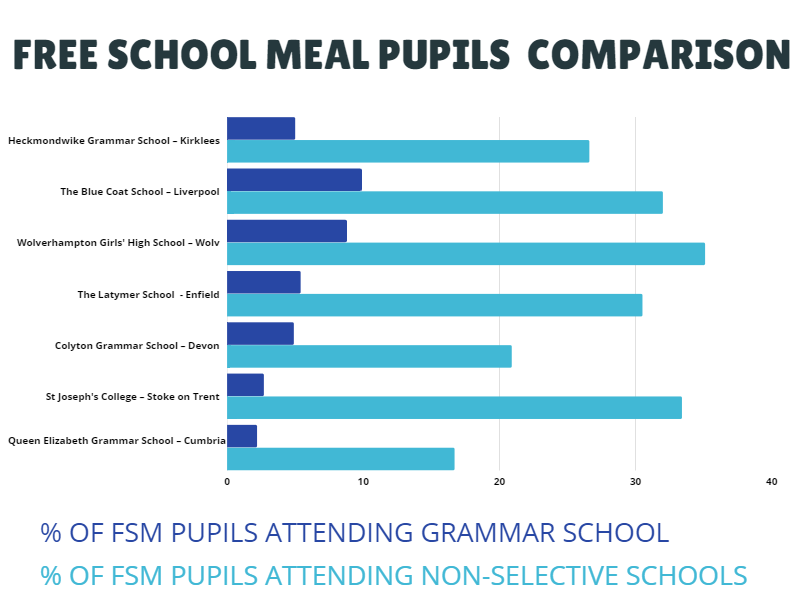 Selective education guide – ‘Stand-alone’ grammar schools
Selective education guide – ‘Stand-alone’ grammar schools
There are seven local authorities with just a single grammar school. In 1965, the Labour government recommended that local education authorities start phasing out grammar schools and secondary modern schools and replace them with a comprehensive system. In some areas, a single grammar school survived while every other secondary school became comprehensive.
The following local authority areas contain a solitary grammar school:
Stoke on Trent – St Joseph’s College
Kirklees – Heckmondwike Grammar School
Enfield – The Latymer School (see also Greater London guide)
Wolverhampton – Wolverhampton Girls’ High School
Liverpool – The Blue Coat School
Cumbria – Queen Elizabeth Grammar School
Devon – Colyton Grammar School
Check out our map of selective schools in England to find out more about these schools. The map gives the percentage of disadvantaged pupils, the percentage of pupils attending a grammar school who are likely to have come from a fee-paying ‘prep’ school, and the relative selectivity of every grammar school in England. View the map HERE.
Or, to read stories from parents and teachers experiencing selective education in areas with grammar schools visit the 11+ Anonymous site HERE.
THE PROBLEMS
In every area where academic selection still exists there are some common problems. For example,
- Grammar schools admit fewer disadvantaged pupils than non-selective schools. Grammar schools are also more likely to admit pupils from more advantaged families.
- A significant number of pupils previously educated in fee-paying ‘prep’ schools take up grammar school places.
- Tuition for the 11-plus ‘buys advantage’. Better-off families can afford private coaching while poorer families may feel compelled to pay for tuition they can ill afford.
- Sitting the 11-plus is stressful and can damage a child’s confidence.
- The 11-plus has been proven to lack accuracy because it takes place while children are still developing academically.
- Research shows the proportion of children with Special Educational Needs (SEN) attending grammar schools is small. For many children with additional learning needs such as dyslexia and attention deficit disorders, the 11-plus test is inaccessible. The same children often perform very well academically outside a test situation.
- Grammar schools change the pupil profile of other schools in the area. If a large number of higher attaining pupils attend grammar schools then surrounding schools find themselves with a pupil population which is skewed, with a disproportionate amount of moderate and lower attaining pupils and pupils with additional learning needs. This impacts on subject choice (fewer subjects available than at a grammar school) and teacher recruitment. Non-selective schools in areas with grammar schools cannot be ‘true’ comprehensives and tend to underperform compared to comprehensive schools.
- GCSE results in areas with grammar schools are on a par, or worse, than areas that have only comprehensive schools. Research has shown that children who attend selective schools would be likely to achieve broadly the same results in a comprehensive school.
The percentage of pupils attending grammar schools
Although a low percentage of pupils attend selective schools in areas with just one grammar school there will still be an impact on surrounding schools.
A social divide in secondary schools
In common with most selective schools, stand-alone grammar schools educate very few disadvantaged pupils. Selective schools create social division because children from more affluent backgrounds tend to cluster in these schools, while non-selective schools educate many more children from low-income families.
 The 11-plus damages children’s confidence
The 11-plus damages children’s confidence
Many children feel demotivated by a ‘fail’ in the 11-plus. We believe all children should start secondary school feeling positive about their academic ability. The success of non-selective schools in most areas of the country proves that there is no need to divide children by using an out of date and discredited test.
More information
You can read more information about individual grammar schools on the websites for each school.
Want to end the 11-plus in your area?
Join Comprehensive Future’s campaign to end the 11-plus.
To learn about the data sources for our interactive map and selective education guides click here. If you spot any errors in the data for any area, please let us know.

